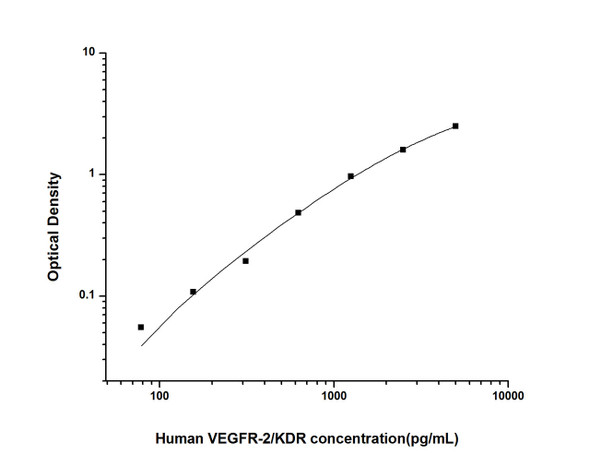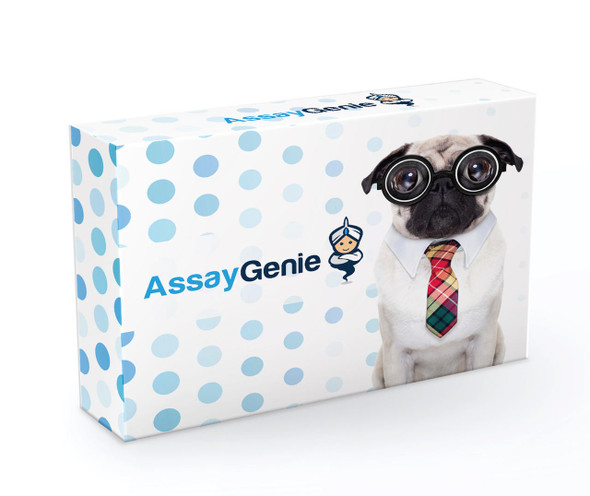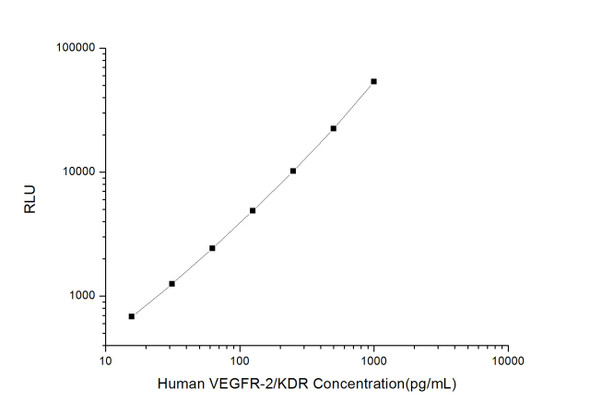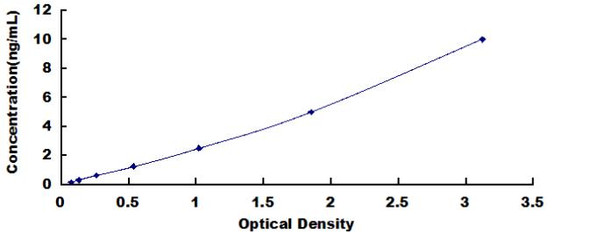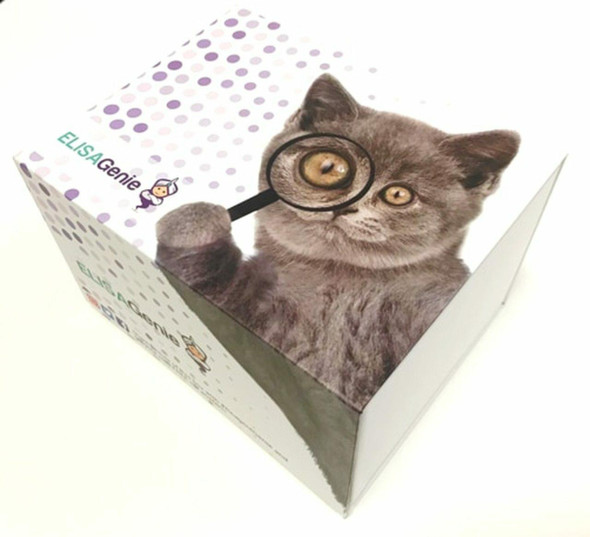Description
Human Vascular endothelial growth factor receptor 2 (KDR) ELISA Kit
The Human Vascular Endothelial Growth Factor Receptor-2 (KDR) ELISA Kit is a powerful tool for accurately measuring levels of KDR in human biological samples such as serum, plasma, and cell culture supernatants. This kit offers exceptional sensitivity and specificity, ensuring precise and reproducible results for a variety of research applications.KDR, also known as VEGFR-2, is a key receptor involved in angiogenesis and vascular development. Its signaling pathway plays a critical role in regulating blood vessel formation and is implicated in diseases such as cancer, cardiovascular disorders, and ophthalmologic conditions.
Therefore, measuring KDR levels can provide valuable insights into the progression of these diseases and may aid in the development of targeted therapies.With its reliable performance and broad utility, the Human Vascular Endothelial Growth Factor Receptor-2 (KDR) ELISA Kit is an indispensable tool for researchers studying angiogenesis, vascular biology, and related fields.
| Product Name: | Human Vascular endothelial growth factor receptor 2 (KDR) ELISA Kit |
| SKU: | HUEB0163 |
| Size: | 96T |
| Target: | Human Vascular endothelial growth factor receptor 2 (KDR) |
| Synonyms: | Fetal liver kinase 1, Kinase insert domain receptor, Protein-tyrosine kinase receptor flk-1, FLK-1, KDR, CD309, VEGFR-2, FLK1, VEGFR2 |
| Assay Type: | Sandwich |
| Detection Method: | ELISA |
| Reactivity: | Human |
| Detection Range: | 0.78-50ng/mL |
| Sensitivity: | 0.39ng/mL |
| Intra CV: | 4.9% | ||||||||||||||||||||
| Inter CV: | 9.8% | ||||||||||||||||||||
| Linearity: |
| ||||||||||||||||||||
| Recovery: |
| ||||||||||||||||||||
| Function: | Tyrosine-protein kinase that acts as a cell-surface receptor for VEGFA, VEGFC and VEGFD. Plays an essential role in the regulation of angiogenesis, vascular development, vascular permeability, and embryonic hematopoiesis. Promotes proliferation, survival, migration and differentiation of endothelial cells. Promotes reorganization of the actin cytoskeleton. Isoforms lacking a transmembrane domain, such as isoform 2 and isoform 3, may function as decoy receptors for VEGFA, VEGFC and/or VEGFD. Isoform 2 plays an important role as negative regulator of VEGFA- and VEGFC-mediated lymphangiogenesis by limiting the amount of free VEGFA and/or VEGFC and preventing their binding to FLT4. Modulates FLT1 and FLT4 signaling by forming heterodimers. Binding of vascular growth factors to isoform 1 leads to the activation of several signaling cascades. Activation of PLCG1 leads to the production of the cellular signaling molecules diacylglycerol and inositol 1,4,5-trisphosphate and the activation of protein kinase C. Mediates activation of MAPK1/ERK2, MAPK3/ERK1 and the MAP kinase signaling pathway, as well as of the AKT1 signaling pathway. Mediates phosphorylation of PIK3R1, the regulatory subunit of phosphatidylinositol 3-kinase, reorganization of the actin cytoskeleton and activation of PTK2/FAK1. Required for VEGFA-mediated induction of NOS2 and NOS3, leading to the production of the signaling molecule nitric oxide (NO) by endothelial cells. Phosphorylates PLCG1. Promotes phosphorylation of FYN, NCK1, NOS3, PIK3R1, PTK2/FAK1 and SRC. |
| Uniprot: | P35968 |
| Sample Type: | Serum, plasma, tissue homogenates, cell culture supernates and other biological fluids |
| Specificity: | Natural and recombinant human Vascular endothelial growth factor receptor 2 |
| Sub Unit: | Homodimer in the presence of bound dimeric VEGFA, VEGFC or VEGFD ligands; monomeric in the absence of bound ligands. Can also form heterodimers with FLT1/VEGFR1 and FLT4/VEGFR2. Interacts (tyrosine phosphorylated) with LFYN, NCK1, PLCG1. Interacts (tyrosine-phosphorylated active form preferentially) with DAB2IP (via C2 domain and active form preferentially); the interaction occurs at the late phase of VEGFA response and inhibits KDR/VEGFR2 activity. Interacts with SHBSH2D2A/TSAD, GRB2, MYOF, CBL and PDCD6. Interacts with HIV-1 Tat (PubMed:10102632, PubMed:10590123, PubMed:12649282, PubMed:12881528, PubMed:1417831, PubMed:15026417, PubMed:15215251, PubMed:15837294, PubMed:15962004, PubMed:16966330, PubMed:17253678, PubMed:18529047, PubMed:18593464, PubMed:19033661, PubMed:19668192, PubMed:20080685, PubMed:20145116, PubMed:20224550, PubMed:20705758, PubMed:21827946, PubMed:21893193, PubMed:9160888). Interacts (via C-terminus domain) with ERN1 (via kinase domain); the interaction is facilitated in a XBP1 isoform 1- and vascular endothelial growth factor (VEGF)-dependent manner in endothelial cells (PubMed:23529610). |
| Research Area: | Cardiovascular |
| Subcellular Location: | Isoform 3 Secreted |
| Storage: | Please see kit components below for exact storage details |
| Note: | For research use only |
| UniProt Protein Function: | VEGFR2: a receptor tyrosine kinase of the VEGFR family. High affinity receptor for VEGF and VEGF-C. Ligand binding induces autophosphorylation and activation. Activated receptor recruits proteins including Shc, GRB2, PI3K, Nck, SHP-1 and SHP-2. Plays a key role in vascular development and regulation of vascular permeability. |
| UniProt Protein Details: | Protein type:Protein kinase, TK; Kinase, protein; Membrane protein, integral; EC 2.7.10.1; Protein kinase, tyrosine (receptor); TK group; VEGFR family Chromosomal Location of Human Ortholog: 4q11-q12 Cellular Component: Golgi apparatus; endoplasmic reticulum; integral to plasma membrane; early endosome; cytoplasmic membrane-bound vesicle; extracellular region; plasma membrane; cell junction; nucleus; endosome; lipid raft; external side of plasma membrane Molecular Function:integrin binding; vascular endothelial growth factor receptor activity; protein binding; growth factor binding; protein-tyrosine kinase activity; receptor signaling protein tyrosine kinase activity; Hsp90 protein binding; transmembrane receptor protein tyrosine kinase activity; ATP binding Biological Process: extracellular matrix organization and biogenesis; positive regulation of positive chemotaxis; peptidyl-tyrosine phosphorylation; viral reproduction; protein amino acid autophosphorylation; cell maturation; calcium ion homeostasis; regulation of cell shape; positive regulation of MAPKKK cascade; positive regulation of focal adhesion formation; ovarian follicle development; positive regulation of cell proliferation; positive regulation of mesenchymal cell proliferation; angiogenesis; vasculogenesis; endothelial cell differentiation; cell fate commitment; embryonic hemopoiesis; positive regulation of phosphoinositide 3-kinase cascade; positive regulation of angiogenesis; cell migration during sprouting angiogenesis; branching morphogenesis of a tube; positive regulation of endothelial cell proliferation; positive regulation of protein amino acid phosphorylation; lymph vessel development; vascular endothelial growth factor receptor signaling pathway; alveolus development; surfactant homeostasis; transmembrane receptor protein tyrosine kinase signaling pathway; negative regulation of apoptosis; positive regulation of cell migration; positive regulation of nitric-oxide synthase biosynthetic process Disease: Hemangioma, Capillary Infantile |
| NCBI Summary: | Vascular endothelial growth factor (VEGF) is a major growth factor for endothelial cells. This gene encodes one of the two receptors of the VEGF. This receptor, known as kinase insert domain receptor, is a type III receptor tyrosine kinase. It functions as the main mediator of VEGF-induced endothelial proliferation, survival, migration, tubular morphogenesis and sprouting. The signalling and trafficking of this receptor are regulated by multiple factors, including Rab GTPase, P2Y purine nucleotide receptor, integrin alphaVbeta3, T-cell protein tyrosine phosphatase, etc.. Mutations of this gene are implicated in infantile capillary hemangiomas. [provided by RefSeq, May 2009] |
| UniProt Code: | P35968 |
| NCBI GenInfo Identifier: | 9087218 |
| NCBI Gene ID: | 3791 |
| NCBI Accession: | P35968.2 |
| UniProt Secondary Accession: | P35968,O60723, Q14178, A2RRS0, B5A925, C5IFA0, |
| UniProt Related Accession: | P35968 |
| Molecular Weight: | 79,634 Da |
| NCBI Full Name: | Vascular endothelial growth factor receptor 2 |
| NCBI Synonym Full Names: | kinase insert domain receptor (a type III receptor tyrosine kinase) |
| NCBI Official Symbol: | KDR |
| NCBI Official Synonym Symbols: | FLK1; CD309; VEGFR; VEGFR2 |
| NCBI Protein Information: | vascular endothelial growth factor receptor 2; soluble VEGFR2; fetal liver kinase 1; fetal liver kinase-1; protein-tyrosine kinase receptor Flk-1; tyrosine kinase growth factor receptor |
| UniProt Protein Name: | Vascular endothelial growth factor receptor 2 |
| UniProt Synonym Protein Names: | Fetal liver kinase 1; FLK-1; Kinase insert domain receptor; KDR; Protein-tyrosine kinase receptor flk-1; CD_antigen: CD309 |
| Protein Family: | Vascular endothelial growth factor receptor |
| UniProt Gene Name: | KDR |
| UniProt Entry Name: | VGFR2_HUMAN |
| Component | Quantity (96 Assays) | Storage |
| ELISA Microplate (Dismountable) | 8×12 strips | -20°C |
| Lyophilized Standard | 2 | -20°C |
| Sample Diluent | 20ml | -20°C |
| Assay Diluent A | 10mL | -20°C |
| Assay Diluent B | 10mL | -20°C |
| Detection Reagent A | 120µL | -20°C |
| Detection Reagent B | 120µL | -20°C |
| Wash Buffer | 30mL | 4°C |
| Substrate | 10mL | 4°C |
| Stop Solution | 10mL | 4°C |
| Plate Sealer | 5 | - |
Other materials and equipment required:
- Microplate reader with 450 nm wavelength filter
- Multichannel Pipette, Pipette, microcentrifuge tubes and disposable pipette tips
- Incubator
- Deionized or distilled water
- Absorbent paper
- Buffer resevoir
*Note: The below protocol is a sample protocol. Protocols are specific to each batch/lot. For the correct instructions please follow the protocol included in your kit.
Allow all reagents to reach room temperature (Please do not dissolve the reagents at 37°C directly). All the reagents should be mixed thoroughly by gently swirling before pipetting. Avoid foaming. Keep appropriate numbers of strips for 1 experiment and remove extra strips from microtiter plate. Removed strips should be resealed and stored at -20°C until the kits expiry date. Prepare all reagents, working standards and samples as directed in the previous sections. Please predict the concentration before assaying. If values for these are not within the range of the standard curve, users must determine the optimal sample dilutions for their experiments. We recommend running all samples in duplicate.
| Step | |
| 1. | Add Sample: Add 100µL of Standard, Blank, or Sample per well. The blank well is added with Sample diluent. Solutions are added to the bottom of micro ELISA plate well, avoid inside wall touching and foaming as possible. Mix it gently. Cover the plate with sealer we provided. Incubate for 120 minutes at 37°C. |
| 2. | Remove the liquid from each well, don't wash. Add 100µL of Detection Reagent A working solution to each well. Cover with the Plate sealer. Gently tap the plate to ensure thorough mixing. Incubate for 1 hour at 37°C. Note: if Detection Reagent A appears cloudy warm to room temperature until solution is uniform. |
| 3. | Aspirate each well and wash, repeating the process three times. Wash by filling each well with Wash Buffer (approximately 400µL) (a squirt bottle, multi-channel pipette,manifold dispenser or automated washer are needed). Complete removal of liquid at each step is essential. After the last wash, completely remove remaining Wash Buffer by aspirating or decanting. Invert the plate and pat it against thick clean absorbent paper. |
| 4. | Add 100µL of Detection Reagent B working solution to each well. Cover with the Plate sealer. Incubate for 60 minutes at 37°C. |
| 5. | Repeat the wash process for five times as conducted in step 3. |
| 6. | Add 90µL of Substrate Solution to each well. Cover with a new Plate sealer and incubate for 10-20 minutes at 37°C. Protect the plate from light. The reaction time can be shortened or extended according to the actual color change, but this should not exceed more than 30 minutes. When apparent gradient appears in standard wells, user should terminatethe reaction. |
| 7. | Add 50µL of Stop Solution to each well. If color change does not appear uniform, gently tap the plate to ensure thorough mixing. |
| 8. | Determine the optical density (OD value) of each well at once, using a micro-plate reader set to 450 nm. User should open the micro-plate reader in advance, preheat the instrument, and set the testing parameters. |
| 9. | After experiment, store all reagents according to the specified storage temperature respectively until their expiry. |
When carrying out an ELISA assay it is important to prepare your samples in order to achieve the best possible results. Below we have a list of procedures for the preparation of samples for different sample types.
| Sample Type | Protocol |
| Serum | If using serum separator tubes, allow samples to clot for 30 minutes at room temperature. Centrifuge for 10 minutes at 1,000x g. Collect the serum fraction and assay promptly or aliquot and store the samples at -80°C. Avoid multiple freeze-thaw cycles. If serum separator tubes are not being used, allow samples to clot overnight at 2-8°C. Centrifuge for 10 minutes at 1,000x g. Remove serum and assay promptly or aliquot and store the samples at -80°C. Avoid multiple freeze-thaw cycles. |
| Plasma | Collect plasma using EDTA or heparin as an anticoagulant. Centrifuge samples at 4°C for 15 mins at 1000 × g within 30 mins of collection. Collect the plasma fraction and assay promptly or aliquot and store the samples at -80°C. Avoid multiple freeze-thaw cycles. Note: Over haemolysed samples are not suitable for use with this kit. |
| Urine & Cerebrospinal Fluid | Collect the urine (mid-stream) in a sterile container, centrifuge for 20 mins at 2000-3000 rpm. Remove supernatant and assay immediately. If any precipitation is detected, repeat the centrifugation step. A similar protocol can be used for cerebrospinal fluid. |
| Cell culture supernatant | Collect the cell culture media by pipette, followed by centrifugation at 4°C for 20 mins at 1500 rpm. Collect the clear supernatant and assay immediately. |
| Cell lysates | Solubilize cells in lysis buffer and allow to sit on ice for 30 minutes. Centrifuge tubes at 14,000 x g for 5 minutes to remove insoluble material. Aliquot the supernatant into a new tube and discard the remaining whole cell extract. Quantify total protein concentration using a total protein assay. Assay immediately or aliquot and store at ≤ -20 °C. |
| Tissue homogenates | The preparation of tissue homogenates will vary depending upon tissue type. Rinse tissue with 1X PBS to remove excess blood & homogenize in 20ml of 1X PBS (including protease inhibitors) and store overnight at ≤ -20°C. Two freeze-thaw cycles are required to break the cell membranes. To further disrupt the cell membranes you can sonicate the samples. Centrifuge homogenates for 5 mins at 5000xg. Remove the supernatant and assay immediately or aliquot and store at -20°C or -80°C. |
| Tissue lysates | Rinse tissue with PBS, cut into 1-2 mm pieces, and homogenize with a tissue homogenizer in PBS. Add an equal volume of RIPA buffer containing protease inhibitors and lyse tissues at room temperature for 30 minutes with gentle agitation. Centrifuge to remove debris. Quantify total protein concentration using a total protein assay. Assay immediately or aliquot and store at ≤ -20 °C. |
| Breast Milk | Collect milk samples and centrifuge at 10,000 x g for 60 min at 4°C. Aliquot the supernatant and assay. For long term use, store samples at -80°C. Minimize freeze/thaw cycles. |


